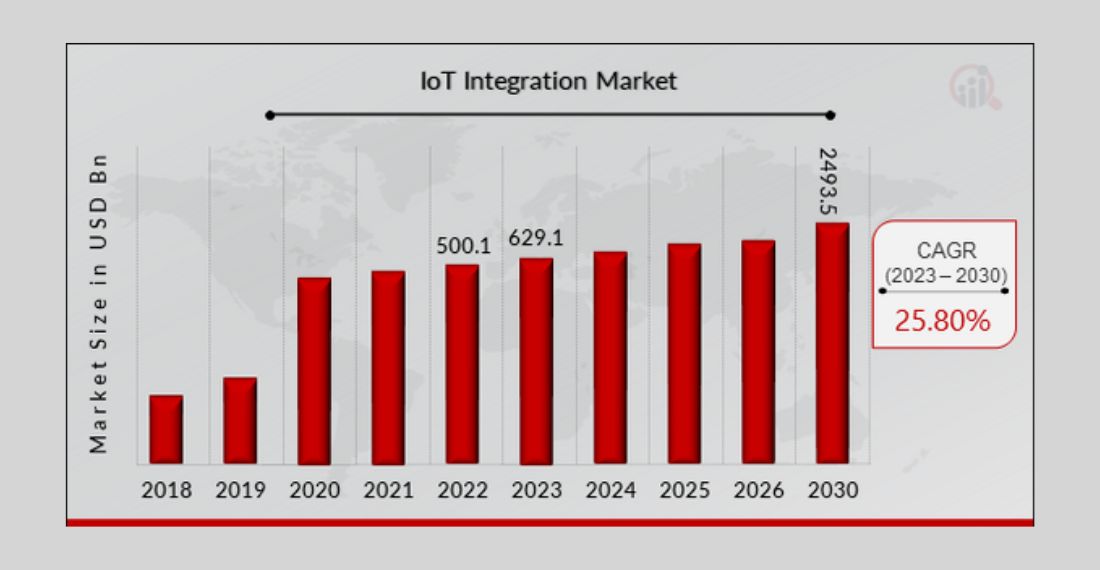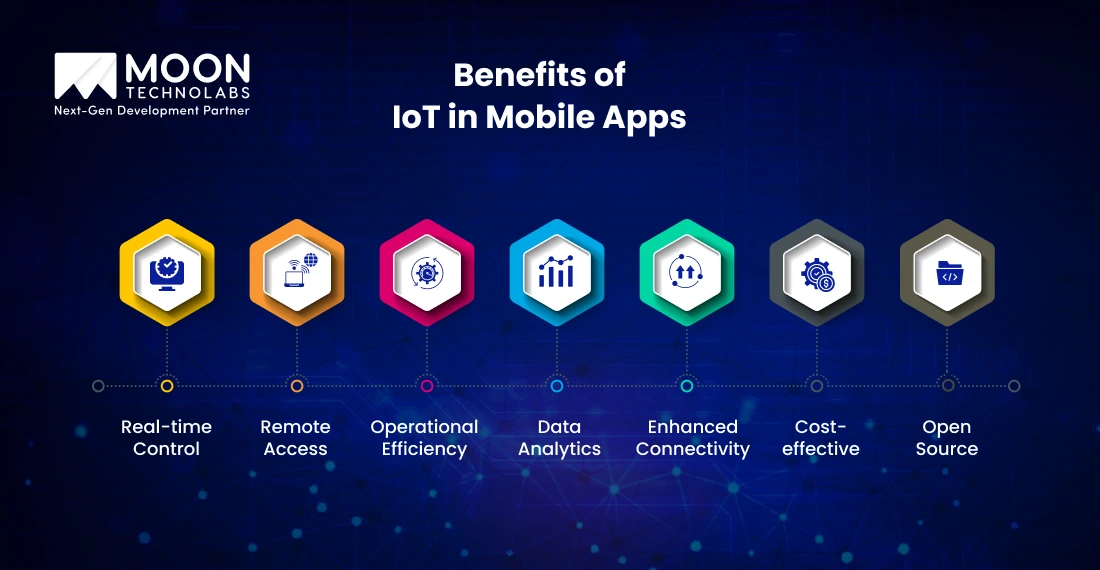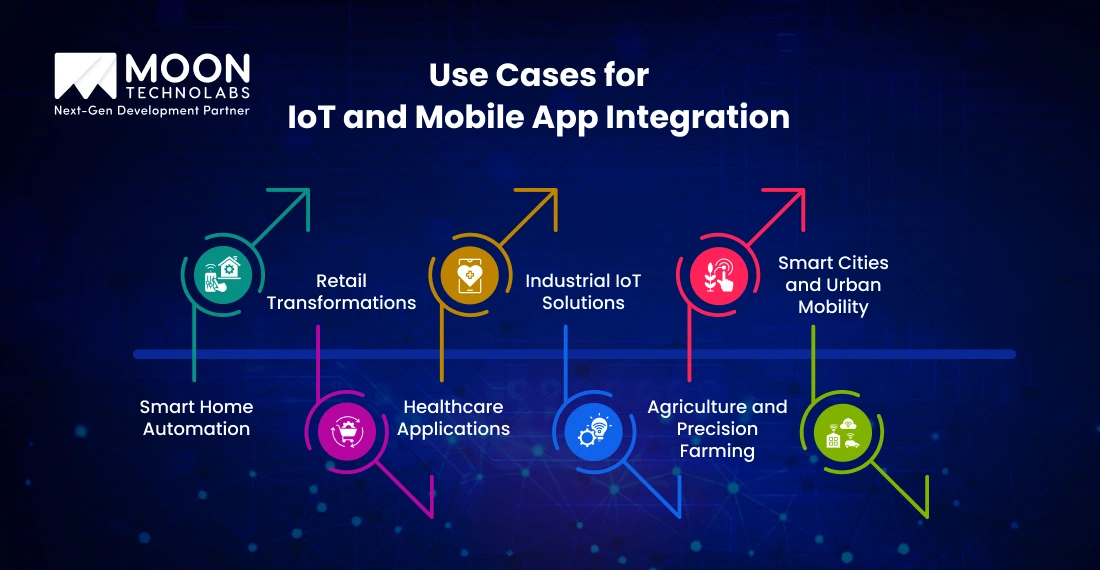Table of Content
Blog Summary:
This blog lets you dive into proven strategies of IoT & mobile app integration and its real use cases. We discuss everything in-depth, including reasons for integration, benefits, integration technologies, and trends.
Table of Content
The integration of IoT and mobile apps is a recent trend for transforming the way users interact with multiple connected devices. It has given a significant boost to the IoT integration market, which is projected to grow from $629.12 billion in 2023 to $ 2,493 billion by 2030 at a CAGR of 28.50%. It reflects the way this trend is soaring in today’s time.

The major advantage of IoT and mobile app integration is that it bridges the gap between wearables, smart sensors, and machines with mobile platforms. It enables businesses to offer real-time monitoring, seamless control, personalized experiences, and more.
The robust synergy between IoT and mobile apps enables businesses to enhance their operational efficiency, allowing them to make data-driven decisions. Additionally, it offers significant innovation across various industries, including manufacturing, healthcare, transportation, home automation, and more.
To avail of all these benefits, you need to develop robust IoT and mobile app integration strategies. We have discussed here the strategies, along with real-world use cases, to help you understand everything clearly.
The integration of IoT and mobile apps has redefined the way people interact with the things around them. In the integration, IoT devices utilize sensors to gather data and transmit it over the internet.
On the other hand, mobile apps serve as an interface that allows users to control and manage connected devices. Whether it’s smart homes, industry automation, or fitness trackers, mobile apps act as remote controls, facilitating users to analyze, control, and receive real-time updates through the use of IoT systems.
This seamless connection enhances operational efficiency and user experience while also paving the way for personalized services across multiple industries.
The integration of IoT with mobile applications is necessary for various reasons. Let’s find out some of them:

The major advantage of IoT integration with mobile apps is that it has redefined the way businesses and customers interact with each other in today’s digital age. It ensures smart decision-making and real-time data exchange. Let’s explore some other major advantages:
The Internet of Things (IoT) in mobile apps enables users to monitor their systems and devices from anywhere, remotely. At the same time, they also get quick updates on status, performance, potential issues, and more.
For instance, a smart home is a good example to illustrate this concept. In this scenario, users utilize their smartphones to control various systems, including security, lighting, thermostats, and other devices.
Apart from this, businesses use it for collecting real-time data from machinery. It helps them discover faults and thus prevents downtime as well. It also works better for maintenance scheduling.
With IoT-powered mobile applications, users get the capability of accessing and controlling multiple connected devices from any location. Whether users wish to adjust the temperature of their home’s AC or manage their commercial fleet of vehicles, they can do so with remote accessibility.
This feature is quite important in many industries, including healthcare. In this industry, every medical staff member monitors patients’ vitals with the help of wearable devices linked through their mobile apps.
IoT-integrated mobile apps can increase operational efficiency by transforming workflows and also automating repetitive tasks. They enable businesses to analyze assets in real-time, minimize human intervention, optimize resource usage, and more in routine tasks.
In the agricultural sector, smart sensors connected via mobile apps can easily monitor soil moisture. It brings automation to irrigation systems, thereby minimizing water wastage while increasing crop production.
For instance, Plent.it is an agriculture IoT platform that caters to businesses of multiple sizes. Whether it’s simplifying farm management, streamlining operations, or connecting with essential resources, the app has the potential to provide everything.
IoT devices produce a large amount of data. Mobile apps gather this data to provide crucial insight by processing and analyzing it. The capabilities of IoT devices make them particularly suitable for personalized user experiences, improved forecasting, smart decision-making, and more.
Retailers can analyze customer behavior with the help of smart shelves and tailor their marketing strategy accordingly. Additionally, logistics service providers can monitor shipment conditions to enhance service delivery.
The IoT improves connectivity, regardless of the system or device. It creates a smooth network that offers real-time communication. In the IoT realm, mobile apps also serve as hubs for device interaction, providing a unified platform for users.
An improved device-to-device communication is necessary for smooth operation and an enhanced user experience, from connected vehicles to cities.
Another advantage of IoT mobile apps is that they also offer enormous possibilities for cost reduction by lowering downtime, optimizing resource utilization, minimizing labor costs, and more. In the manufacturing sector, predictive maintenance ensures great prevention of equipment from failure.
It also works effectively in improving the lifespan of machinery. It also enables businesses to minimize energy consumption and make informed decisions to minimize utility costs.
Open-source IoT platforms reduce the effort required by developers to create feature-oriented and scalable mobile apps. Open-source frameworks are essential for minimizing development time, promoting innovation, and reducing costs, among other benefits.
Developers have the opportunity to customize apps, integrate third-party APIs, and leverage community support to offer powerful IoT solutions tailored to meet specific requirements.
Build a Robust IoT App that integrates smoothly with a range of devices, boosts automation, and delivers real-time data.
Let’s Connect Now
To ensure a seamless integration of IoT and mobile apps, you need to leverage a range of technologies. Let’s understand some of the popular technologies:
When it comes to cloud computing, it’s one of the major technologies for integrating IoT and mobile apps. It provides a scalable infrastructure for data storage, processing, and management.
With cloud technology, IoT devices can transmit a vast amount of data to centralized servers. It allows mobile applications to access real-time information from any location. It provides vast support for remote device management. It enables over-the-air (OTA) updates to IoT devices, ensuring they stay current without requiring manual intervention.
Cutting-edge data analytics tools can process data, identify patterns, optimize performance, detect anomalies, and perform other advanced functions. When you integrate it into mobile apps, it enhances the user experience by providing personalized suggestions and predictive insights.
For instance, fitness apps are integrated into wearable devices that can analyze health metrics to recommend workouts or lifestyle changes.
APIs serve as a communication bridge between mobile applications and Internet of Things (IoT) devices. It simplifies the overall complexity of connecting multiple systems, enabling developers to incorporate IoT functionalities into mobile apps without having to develop every feature from scratch.
MQTT and RESTful APIs are commonly used in IoT mobile apps to ensure efficient communication between smart devices and mobile applications.
Whether it is Google Cloud, AWS, or Microsoft Azure, various platforms are capable of offering end-to-end IoT mobile applications. These platforms offer a range of tools for various purposes, including data integration, device management, security, and analytics.
They streamline development and minimize the time and cost required to bring IoT-driven apps to market. It allows developers to develop, test, and implement apps.
Developers leverage cross-platform mobile applications that integrate smoothly with IoT ecosystems. Some of these popular frameworks include React Native, Flutter, Xamarin, and more.
These frameworks speed up the development process with ease of customization. They also facilitate developers in creating an intuitive user interface that allows users to control smart devices. It’s also necessary for compatibility across operating systems.
The IoT app development is a highly responsible task that requires a proper strategy to match user-centric and technical elements. Let’s understand various important strategies you can implement to build a solid IoT mobile app.
Before you indulge entirely in the development process, you need to define the use case clearly. It’s crucial to understand the issue the app solves to help share the complete development process, whether it’s health tracking, industrial monitoring, logistics management, home automation, or more.
A clearly defined use case aligns perfectly with business objectives and user requirements. It ensures the final product delivers complete value.
When it comes to IoT platforms, a mobile app needs to support various purposes, including data collection, managing device connectivity, analytics, and integration with different cloud services.
These platforms are available with powerful tools and higher scalability. It’s essential to select the right platform for seamless development and deployment.
The efficiency of an IoT app relies heavily on the communication protocols used. So, it’s crucial to select the right protocols to ensure higher efficiency of your IoT apps. You can select the right one from some popular options such as CoAP, MQTT, and HTTP/HTTPS. Each protocol offers unique advantages.
For instance, MQTT is the best option for lightweight and low-bandwidth environments. You can select the protocol based on several factors, including device limitations, transmission requirements, latency needs, and other relevant considerations.
Your IoT apps should be scalable to handle the growing number of devices and data volume. A scalable infrastructure is necessary to make your app continue to perform superbly even during increased load.
Therefore, you need to leverage technologies such as edge computing, microservices, and cloud-based solutions. These are essential for higher flexibility and also for your future growth.
IoT devices often face situations like cyber threats, which makes security the topmost concern. To make your IoT app’s security robust, you need to implement secure APIs, end-to-end encryption, regular firmware updates, and other measures to ensure the safety of user data.
Additionally, authentication and access control mechanisms are crucial for preventing unauthorized access to applications and devices.
An intuitive interface is essential to prevent your IoT system from failing, regardless of its level of advancement. You need to emphasize creating a user-friendly mobile interface with simple navigation, clear visuals, responsive design, and other key features.
Users should have the capability to easily monitor, control, and receive notifications from their devices. Consistency and clarity across screens improve both usability and satisfaction.
Since the IoT environment is diverse, it’s essential to perform comprehensive testing across a range of platforms, devices, and real-world scenarios. Whether it’s latency issues, inferior connectivity, or device failures, they ensure the app’s reliable performance under every condition.
A large number of IoT devices work in multiple environments with intermittent connectivity and limited power. You need to optimize your mobile application to manage power usage with higher efficiency.
You need to incorporate data caching and offline mode, which ensures the app remains fully functional even during connectivity lapses.
You need to understand that IoT technology is growing fast. It’s essential to design your app with flexibility and modularity to accommodate future updates and integrate with new platforms or devices.
You can implement over-the-air updates for a smooth deployment of software upgrades and bug fixing. It ensures your app remains highly secure and relevant.
We help you connect your app to the future with a smooth IoT integration. It’s time to unlock real-time data, smart experience, and higher scalability.
Schedule a Consultation Now

Many industries leverage the power of IoT and mobile app integration to gain higher control, data-driven insights, and efficiency. We have covered below how these industries leverage this integration by providing real use cases:
When it comes to smart home solutions, these are the most popular and fast-growing applications of IoT. By using only their smartphones, users get the ability to control lights, home security systems, thermostats, and kitchen appliances with the help of their smartphones.
Mobile apps serve as a central hub, enabling the automation and remote monitoring of various tasks. For instance, homeowners get the ability to adjust temperature settings, receive alerts, view live security camera feeds, and more. All of these are possible with the use of a mobile interface.
A large number of retail businesses have recently adopted IoT to enhance customer experience and optimize operations. Whether it’s RFID tags, smart shelves, or beacon technology, they have the power to connect mobile apps, providing personalized promotions, real-time inventory tracking, in-store navigation, and more.
Customers can receive product recommendations, check product availability, or navigate directly to an item’s location in-store via the retailer’s app. It makes shopping more efficient and engaging.
Healthcare is another industry that harnesses the unmatched power of IoT-driven apps. They utilize a variety of healthcare devices, including glucose monitors, fitness trackers, smart inhalers, and more. These help collect patient data continuously.
When you integrate with mobile apps, these devices enable patients and many healthcare providers to analyze health metrics in real-time. Doctors receive quick updates on vital signs, enabling them to intervene early.
Meanwhile, patients can easily track their medication schedules, progress, and receive reminders with the help of mobile notifications.
Industrial IoT (IIoT), combined with a large number of mobile applications, enhances safety, productivity, and predictive maintenance. Sensors incorporated in machinery gather data on temperature, performance, and usage patterns.
This kind of information is indeed highly accessible with the help of a mobile dashboard, which allows managers and operators to monitor schedule maintenance, health, and prevent costly downtimes. Mobile alerts enable technicians to receive timely notifications of important issues, ensuring a rapid response and uninterrupted production.
The Internet of Things (IoT) has revolutionized agriculture, thanks to the use of drones, smart sensors, and automated irrigation systems. These tools are capable of collecting data on crop health, soil conditions, weather patterns, and other relevant factors. Mobile apps allow farmers to gain complete insight and control at their fingertips.
For instance, farmers can analyze soil moisture levels and activate irrigation with the help of a mobile application. It optimizes water usage and also improves crop yields. Apart from this, real-time notifications are useful for quickly discovering pest infestations or equipment malfunctions.
Smart cities mainly rely on the Internet of Things and mobile app integration to boost urban living. Mobile applications connected to IoT networks can provide public transportation schedules, real-time traffic updates, parking availability, and other relevant information.
Shared mobility services, including bike-sharing and e-scooter services, heavily rely on mobile applications for tracking, access, and payment. Environmental monitoring and smart waste management systems provide residents and city officials with updated information to make improved decisions.
With the rapid evolution of technology, several important trends are emerging that will reshape the future of the IoT and mobile app ecosystem. Let’s discuss some of the ongoing trends that have gained much prominence in this integration:
Edge computing is one of the emerging technologies that has gained huge prominence in today’s time. It enables quick decision-making in applications such as autonomous vehicles, healthcare monitoring, industrial manufacturing automation, and more.
Mobile apps that leverage this technology have the potential to minimize dependency on cloud networks, boost reliability, and deliver real-time alerts.
Artificial Intelligence and Machine Learning are two of the most popular technologies that can harness the unmatched potential of the Internet of Things. Mobile apps that leverage AI/ML are capable of predicting user behavior, analyzing sensor data, automating routines, and providing intelligent feedback.
For instance, smart home apps utilize machine learning (ML) to adjust temperature and lighting according to user preferences.
Interoperability has become highly important in today’s growing number of connected platforms and devices. Mobile apps now have the potential to support cross-platform communication with the use of standardized protocols.
It enables devices from various manufacturers to interact smoothly. It creates a unified ecosystem that improves user experience and operational efficiency.
The emergence of 5G networks has intensified the adoption rate of IoT. The technology increases the potential of mobile apps in IoT, with ultra-low latency, higher bandwidth, and more.
It offers possibilities for real-time streaming, faster data transmission, and optimal support for high-density IoT deployments, including connected vehicles and smart cities.
Security is something that should always be of top priority, with the increasing number of connected devices. Developers implement various security measures, including secure boot mechanisms, end-to-end encryption, blockchain technologies, biometric authentication, and other security protocols.
These are useful for ensuring the safety of data and preventing breaches.
We possess expertise in seamlessly integrating IoT with mobile apps, aiming to provide you with impeccable, connected, and smart solutions.
Our developers possess sufficient experience to leverage mobile technologies and IoT frameworks, enabling remote monitoring, real-time data exchange, and device control through user-friendly mobile interfaces.
Our team offers comprehensive end-to-end IoT app development services, encompassing security protocols and seamless cloud integration. We help businesses optimize their operations and enhance user experiences.
Whether it’s healthcare, smart homes, manufacturing, or logistics, we create secure, scalable mobile IoT app solutions tailored to match specific requirements.
Integrating IoT with mobile apps presents a significant opportunity for innovation across various industries. It offers them numerous benefits, including increased efficiency, enhanced connectivity, and an improved user experience. Right from precision farming to smart cities, the possibilities are endless.
By adopting the right technologies, strategies, and platforms, businesses can unlock the full potential of IoT. Getting in touch with Moon Technolabs helps you create scalable, secure, and future-ready solutions tailored to match your unique requirements.
01
02
03
04
05
Submitting the form below will ensure a prompt response from us.